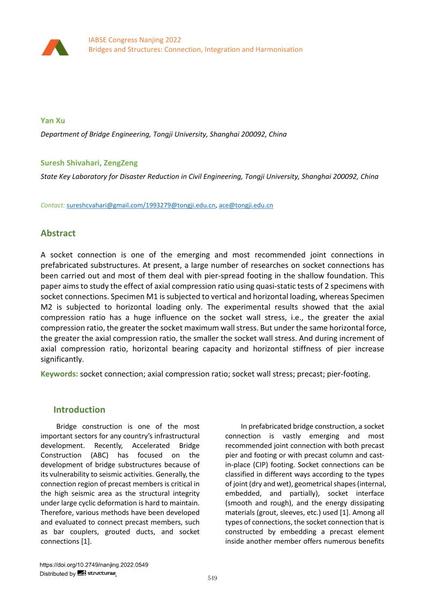Effects of Axial Compression Ratio in Socketed Precast Pier-Footing Connection

|
|
|||||||||||
Détails bibliographiques
| Auteur(s): |
Yan Xu
(Department of Bridge Engineering, Tongji University, Shanghai 200092, China)
Suresh Shivahari (State Key Laboratory for Disaster Reduction in Civil Engineering, Tongji University, Shanghai 200092, China) ZengZeng (State Key Laboratory for Disaster Reduction in Civil Engineering, Tongji University, Shanghai 200092, China) |
||||
|---|---|---|---|---|---|
| Médium: | papier de conférence | ||||
| Langue(s): | anglais | ||||
| Conférence: | IABSE Congress: Bridges and Structures: Connection, Integration and Harmonisation, Nanjing, People's Republic of China, 21-23 September 2022 | ||||
| Publié dans: | IABSE Congress Nanjing 2022 | ||||
|
|||||
| Page(s): | 549-555 | ||||
| Nombre total de pages (du PDF): | 7 | ||||
| DOI: | 10.2749/nanjing.2022.0549 | ||||
| Abstrait: |
A socket connection is one of the emerging and most recommended joint connections in prefabricated substructures. At present, a large number of researches on socket connections has been carried out and most of them deal with pier-spread footing in the shallow foundation. This paper aims to study the effect of axial compression ratio using quasi-static tests of 2 specimens with socket connections. Specimen M1 is subjected to vertical and horizontal loading, whereas Specimen M2 is subjected to horizontal loading only. The experimental results showed that the axial compression ratio has a huge influence on the socket wall stress, i.e., the greater the axial compression ratio, the greater the socket maximum wall stress. But under the same horizontal force, the greater the axial compression ratio, the smaller the socket wall stress. And during increment of axial compression ratio, horizontal bearing capacity and horizontal stiffness of pier increase significantly. |
||||
| Copyright: | © 2022 International Association for Bridge and Structural Engineering (IABSE) | ||||
| License: | Cette oeuvre ne peut être utilisée sans la permission de l'auteur ou détenteur des droits. |
||||
